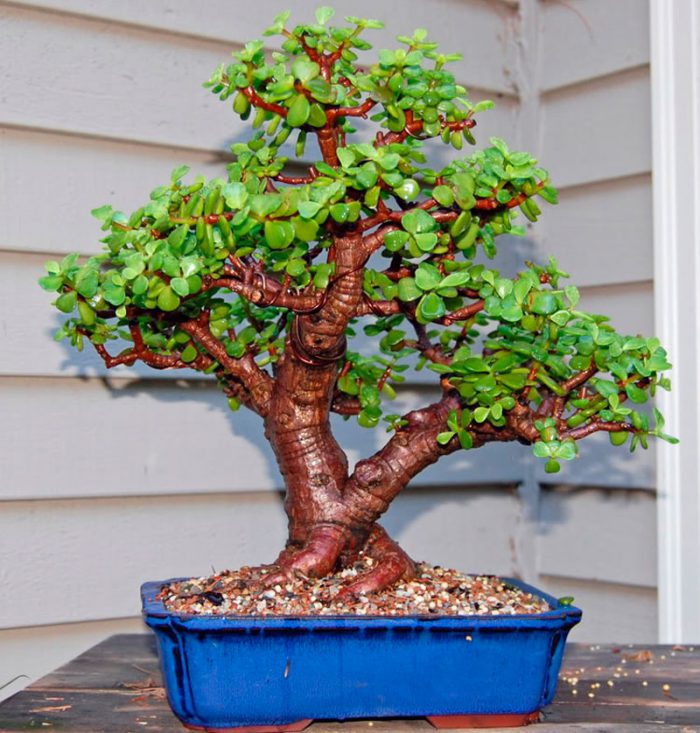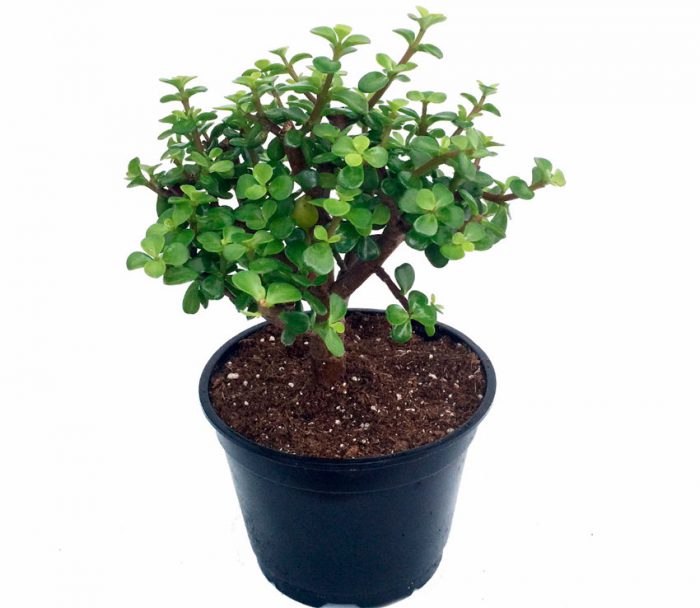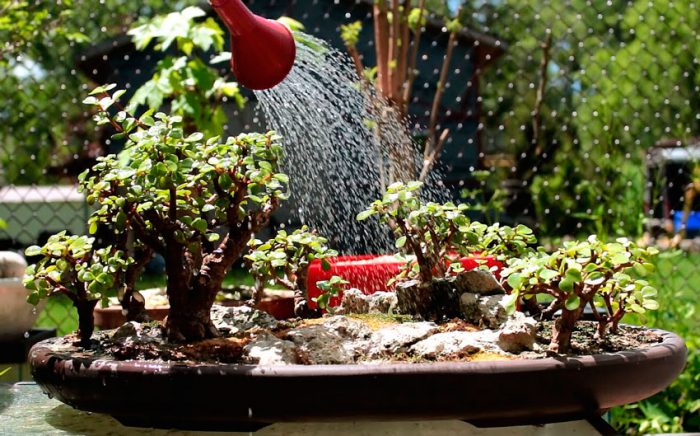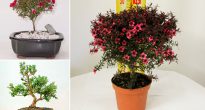A kind of plants like portulacaria (Portulacaria) is directly related to the purslane family. In nature, such a plant can be found in the arid hot regions of South Africa. According to data from various sources, this genus unites about 5 species or is monotypic, that is, it is represented by only 1 species - portulacaria african (Portulacaria afra), which is also called "elephant bush".
Portulacaria African is a strongly branching woody shrub that can reach a height of 3.5 meters. It has a few shoots that grow erratically and thick, fleshy stems. Young stems are colored lilac-red, but over time they become covered with wrinkled dark brown bark. Short internodes, while the nodes are clearly visible. Peteless, oppositely located, juicy leaves are relatively small in size, so, in length they reach from 2 to 3 centimeters, and in width - from 1 to 2 centimeters. The wide-oval shape of the leaves has a slightly pointed tip. Abundant flowering. The flowers are small (2–2.5 mm in diameter), five-petal, pink in color. They are collected in axillary inflorescences that have the shape of an ear and reach a length of 7.5 centimeters. Such inflorescences are located at the tops of the shoots.
The original appearance has pale green foliage. But there are forms with a purple-pinkish edge of the leaves. Also, on the surface of the sheet plate, there may be wide, shapeless, light spots, which in some cases almost completely discolor it.
Content
Caring for purslane at home
This plant is distinguished by its unpretentiousness, so even inexperienced growers can easily grow it.
Illumination
In order for the plant to grow and develop normally, it needs good bright lighting, and at the same time, direct rays of the sun must be present. In this regard, a south-facing window will suit him perfectly. To form a beautiful uniform crown, you can resort to one trick. Namely, it is necessary to regularly turn the pot with purslane in different directions to the light source.
In winter, such a plant will need additional supplementary lighting with special phytolamps.
Temperature regime
You feel quite comfortable in the mid-latitude climate in the summer. In the spring and summer, it is recommended to move it to fresh air (to the garden, to the balcony).It should be remembered that such a flower simply needs fresh air, therefore, when growing in a room, systematic ventilation will be needed.
Portulacaria needs a cool winter. In this case, it is necessary to ensure that the temperature in the room where the plant is located is not lower than 10 degrees. Otherwise, the fleshy leaves freeze and become lethargic.
How to water
Such a succulent is quite accustomed to arid climates, where rain is a comparative rarity. Therefore, when grown indoors, it should be provided with similar conditions. So, it is recommended to water it only after the soil in the pot dries out by 1/3 part. With a cool winter, watering should be more scarce and rare, because the root system and foliage, with excessive absorption of water, rot very quickly.
If watering has not been done for a long enough time, then the foliage on the plant becomes shriveled. However, after it has been watered, the leaves will become smooth again.
Water should be watered with water at room temperature, in which there is no chlorine. If the tap water is not chlorinated, then you can use it without prior settling. In this case, the hardness of the water does not play a special role.
Humidity
It is not necessary to artificially increase the air humidity. But for hygienic purposes, it is recommended to arrange a warm shower for the plant, which will help remove dust accumulated on the leaves.
Fertilizer
During intensive growth, top dressing is carried out at a frequency of 1 time in 2 weeks. For this, fertilizers with a low nitrogen content are used. So, ready-made liquid fertilizer for succulents and cacti is perfect. From mid-autumn to mid-spring, all feeding stops.
Earth mix
A suitable substrate should be loose, low in nutrients and permeable to water and air. In order to prepare a soil mixture, you need to combine the purchased soil for succulents and cacti with coarse sand (can be replaced with vermiculite) and brick chips (or fine gravel), which should be taken in a ratio of 3: 1: 1.
Transplant features
This plant has a relatively slow growth. In this regard, regular frequent transplants are needed only for very young specimens. An adult plant needs to be transplanted only if necessary, so when the root system completely fills the container.
Reproduction methods
As a rule, when grown indoors, they are propagated by cuttings. At the same time, fairly thick branches are suitable for cuttings, on which there should be 4 internodes. After pruning, they are left in the open air for 1-2 days for drying, after which they are planted for rooting in a mixture of sand and peat. The first roots should appear after 2-3 weeks. After 2-3 months, you can transplant the rooted cuttings into a permanent pot.
It can be propagated by seeds, but buying them can be difficult.
Pests and diseases
Sufficiently resistant to pests. However, on such a plant you can find mealybugs, scale insects or spider mites... As soon as these pests are found, the plant needs a warm shower. With a strong infection, you will also need an insecticide treatment of the appropriate action.
Resistant to disease. But he can get sick due to violation of the rules of care. For example, with abundant watering, especially in a cool room, a variety of rot may appear.
Partial loss of foliage can happen due to lack of light in winter or for other reasons. But when the plant is placed in favorable conditions, the leaves grow quickly.















